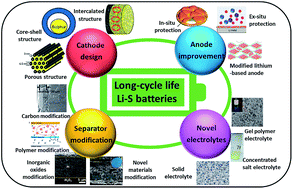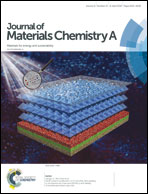Effective strategies for long-cycle life lithium–sulfur batteries
Abstract
Lithium–sulfur (Li–S) batteries have attracted considerable attention due to their high theoretical energy density and low cost. However, their practical applications are greatly limited by rapid capacity degradation because of the unfavorable reaction between soluble intermediate polysulfides and the lithium anode. Recently, various strategies have been devoted to addressing the above polysulfide shuttle issue and to improving the performance of Li–S batteries. Herein, a comprehensive review related to sulfur-based cathode designs, separator functional-modifications, lithium anode improvements, and novel electrolyte systems is presented for extending the cycle life of Li–S batteries. In addition, the prospects of promising approaches regarding the development of practical Li–S batteries are presented.

- This article is part of the themed collection: Recent Review Articles


 Please wait while we load your content...
Please wait while we load your content...